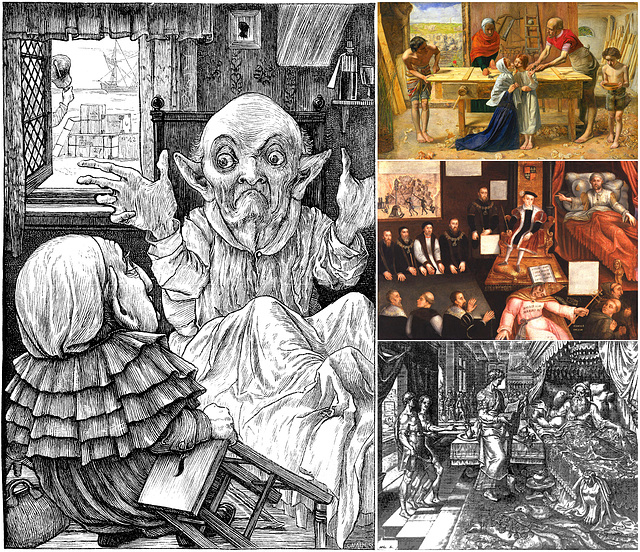Kerchiefs and other shapes
Thumb & Lappet
The Carpenter and Ahasuerus
John Everett Millais: Lorenzo and Isabella (detail…
Holiday - Millais- Anonymous - Galle, detail
Wood Shavings turned Pope (1st version)
The Butcher & the young Raleigh (details)
Holiday - Millais - Anonymous - Galle; detail
Carpenters Shop and Millais' Allusions
Wood Shavings turned Pope
Mary's and the Baker's Kerchiefs
42 Boxes, Sheep, Iconoclasm
Millais, Anonymous, Galle
Holiday - Millais - Anonymous - Galle
Holiday - Millais- Anonymous - Galle, detail
See also...
See more...Keywords
Authorizations, license
-
Visible by: Everyone -
All rights reserved
-
2 849 visits
Holiday - Millais - Anonymous - Galle


See also: www.academia.edu/9856486/Henry_Holiday_-_and_Millais_Christ_in_the_House_of_His_Parents_
.
The discovery here is the allusion by Henry Holiday to the painting by J.E. Millais. Finding Millais' allusions to an anonymous painter and to Galle's print is a "bycatch" of my Snark hunt. The relation between the anonymous painting and Galle's print already has been explained by Margaret Aston in 1994. That relation brobably has been discovered even earlier by Millais.
.
[left]: Henry Holiday: Depiction (1876) of the Baker's visit to his uncle in Lewis Carroll's "The Hunting of the Snark" (engraved by Joseph Swain). Outside of the window are some of the Baker's 42 boxes.
[right top]: John Everett Millais: Christ in the House of His Parents aka The Carpenter's Shop (1850).
Location: Tate Britain (N03584), London.
Literature:
* Deborah Mary Kerr (1986): John Everett Millais's Christ in the house of his parents (circle.ubc.ca/handle/2429/26546)
p.34 in (01) Éva Péteri (2003): Victorian Approaches to Religion as Reflected in the Art of the Pre-Raphaelites, Budapest 2003, ISBN 978-9630580380 (shortlink: www.snrk.de/EvaPeteri.htm)
* Albert Boime (2008): Art in an Age of Civil Struggle, 1848-1871
p. 225-364: The Pre-Raphaelites and the 1848 Revolution (en.wikipedia.org/wiki/Special:BookSources/0226063283)
[right middle]: Anonymous: Edward VI and the Pope, An Allegory of Reformation, mirrored view (16th century, NPG 4165). Iconoclasm depicted in the window. Under the "window" 3rd from left is Thomas Cranmer who wrote the 42 Articles in 1552.
Edward VI and the Pope (NPG 4165) was, until 1874, the property of Thomas Green, Esq., of Ipswich and Upper Wimpole Street, a collection 'Formed by himself and his Family during the last Century and early Part of the present Century' (Roy C. Strong: Tudor and Jacobean Portraits, 1969, p.345). Thus, when Millais' Christ in the House of His Parents ('The Carpenter's Shop') was painted in 1849-1850, the 16th century painting was part of a private collection. It was sold by Christie's 20 March 1874 (lot 9) to a buyer unknown to me, that is, when Holiday started with his illustrations to The Hunting of the Snark.
Location: National Portrait Gallery, London
[right bottom]: Philip Galle after Maarten van Heemskerck, Redrawn print Ahasuerus consulting the records (1564). The resemblance to the image above (right middle) was shown by Dr. Margaret Aston in 1994 in The King's Bedpost: Reformation and Iconography in a Tudor Group Portrait (p. 68). She also compared the bedpost to Heemskerck's Esther Crowned by Ahasuerus.
Location: Rijksmuseum, Amsterdam
.
The discovery here is the allusion by Henry Holiday to the painting by J.E. Millais. Finding Millais' allusions to an anonymous painter and to Galle's print is a "bycatch" of my Snark hunt. The relation between the anonymous painting and Galle's print already has been explained by Margaret Aston in 1994. That relation brobably has been discovered even earlier by Millais.
.
[left]: Henry Holiday: Depiction (1876) of the Baker's visit to his uncle in Lewis Carroll's "The Hunting of the Snark" (engraved by Joseph Swain). Outside of the window are some of the Baker's 42 boxes.
[right top]: John Everett Millais: Christ in the House of His Parents aka The Carpenter's Shop (1850).
Location: Tate Britain (N03584), London.
Literature:
* Deborah Mary Kerr (1986): John Everett Millais's Christ in the house of his parents (circle.ubc.ca/handle/2429/26546)
p.34 in (01) Éva Péteri (2003): Victorian Approaches to Religion as Reflected in the Art of the Pre-Raphaelites, Budapest 2003, ISBN 978-9630580380 (shortlink: www.snrk.de/EvaPeteri.htm)
* Albert Boime (2008): Art in an Age of Civil Struggle, 1848-1871
p. 225-364: The Pre-Raphaelites and the 1848 Revolution (en.wikipedia.org/wiki/Special:BookSources/0226063283)
[right middle]: Anonymous: Edward VI and the Pope, An Allegory of Reformation, mirrored view (16th century, NPG 4165). Iconoclasm depicted in the window. Under the "window" 3rd from left is Thomas Cranmer who wrote the 42 Articles in 1552.
Edward VI and the Pope (NPG 4165) was, until 1874, the property of Thomas Green, Esq., of Ipswich and Upper Wimpole Street, a collection 'Formed by himself and his Family during the last Century and early Part of the present Century' (Roy C. Strong: Tudor and Jacobean Portraits, 1969, p.345). Thus, when Millais' Christ in the House of His Parents ('The Carpenter's Shop') was painted in 1849-1850, the 16th century painting was part of a private collection. It was sold by Christie's 20 March 1874 (lot 9) to a buyer unknown to me, that is, when Holiday started with his illustrations to The Hunting of the Snark.
Location: National Portrait Gallery, London
[right bottom]: Philip Galle after Maarten van Heemskerck, Redrawn print Ahasuerus consulting the records (1564). The resemblance to the image above (right middle) was shown by Dr. Margaret Aston in 1994 in The King's Bedpost: Reformation and Iconography in a Tudor Group Portrait (p. 68). She also compared the bedpost to Heemskerck's Esther Crowned by Ahasuerus.
Location: Rijksmuseum, Amsterdam
Hans-Georg Kaiser has particularly liked this photo
- Keyboard shortcuts:
Jump to top
RSS feed- Latest comments - Subscribe to the comment feeds of this photo
- ipernity © 2007-2024
- Help & Contact
|
Club news
|
About ipernity
|
History |
ipernity Club & Prices |
Guide of good conduct
Donate | Group guidelines | Privacy policy | Terms of use | Statutes | In memoria -
Facebook
Twitter

Henry Holiday's allusions to "The Allegory of Iconoclasm" by Marcus Gheeraerts the Elder:
Sign-in to write a comment.